I’ve got an interesting piece of pipe history to share this week. I acquired this Wally Frank longpipe in trade for some restoration work almost a year ago but it got sidelined and was forgotten in my refurb box until now.
Wally Frank Ltd was established in 1931 as a chain of tobacconists and pipe sellers. The stores and mail-order catalog business were well received, in part due to the depth of their product lines encompassing a number of well-known pipe brands as well as their own house series, the production of which was contracted out to established pipemakers in North America and across Europe.
A browse through old Wally Frank catalogs online (the 1937 edition is available on RebornPipes.com here) show that the company carried a little bit of everything, and usually at a discount – briars, meerschaum, figurals, clays, and even hookahs in addition to pipe cleaners, tools, tampers and racks.
This Wally Frank Ltd pipe is clearly a nod to one of France’s noted pipe houses, Butz-Choquin. That firm’s first pipe, L’Origine, was what the French called a “longpipe” or reading pipe, what many pipers nowadays would call a churchwarden.
Instead of a long wood or vulcanite stem, the shank extension on the original Butz-Choquin pipe was made from a length of albatross wing bone. That and the distinctive silver fittings set the pipe apart from its competitors when introduced in 1858.
A few years ago, Butz-Choquin introduced a series of commemorative pipes, “A Metz Origine”, reproducing the first Choquin longpipe but substituting acrylic in place of the albatross bone extension and nickel fittings instead of silver. This pic shows the re-issued pipe.

Looking now at the Wally Frank pipe on my worktable, the inescapable conclusion is that it was made by Butz-Choquin for Wally Frank. Barring the Wally Frank’s use of briar as shank extension material, the two pipes are exactly the same – length, width, chamber size and even weight match up perfectly.
DIMENSIONS
Pipe Length : 210mm
Pipe Height : 55mm
Pipe Width : 36mm
Chamber Width : 19mm
Chamber Depth : 49mm
Pipe Weight : 54grams
This series of pics shows the pipe as it looked when I brought it to the worktable.

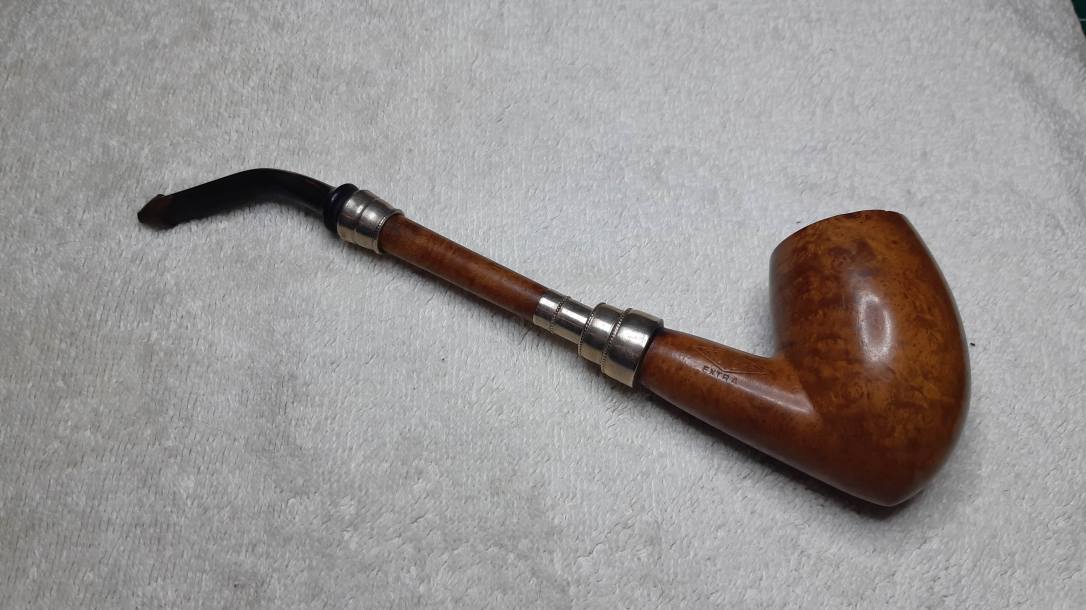

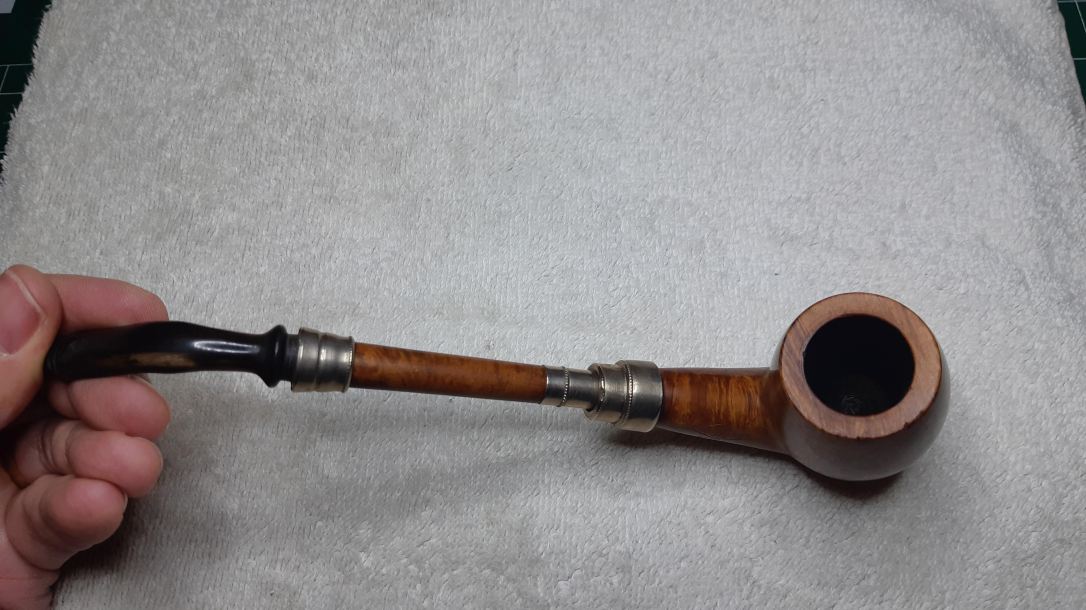

The pipe was in quite good condition – it had come to me in a padded leatherette pipe sock in which it had likely spent most of its life. The chamber showed very little sign of use though there was a bit of carbon lurking within. The nickel fittings were a bit tarnished, but the briar, for the most part, retained a nice shine from the last time the pipe was waxed.
There were a few dents on the outer rim of the bowl and on the stummel’s nickel spigot fitting, probably caused by someone accidentally dropping the pipe. The stem was dull and somewhat discoloured. More on that later.
The pipe is stamped on the left shank with “WALLY FRANK” over “LTD”, “Bruyere” in a diamond over “EXTRA” on the right shank and “FRANCE” parallel to the shank face just under the spigot fitting.


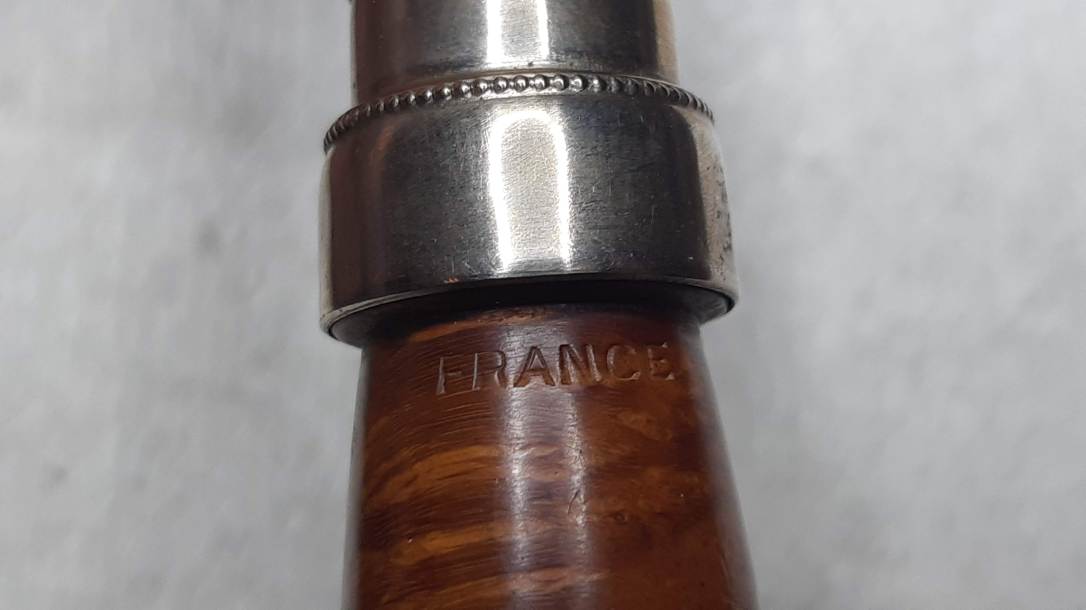
I could find nothing online to help me date this particular pipe. Wally Frank Ltd operated from 1931 until at least 1970. If anyone knows exactly when the firm closed, I’d love to know! After consulting with Steve Laug of RebornPipes.com, the consensus is that this pipe was likely made sometime in the 1960’s, about the same time that Butz-Choquin entered the export pipe market. Coincidence?
I broke the pipe down into its composite pieces – bowl, shank extension and bit. The nickel cap on the briar shank extension, half of the spigot fitting, came off in my hand – perhaps the cause of the accidental drop that dented the rim?
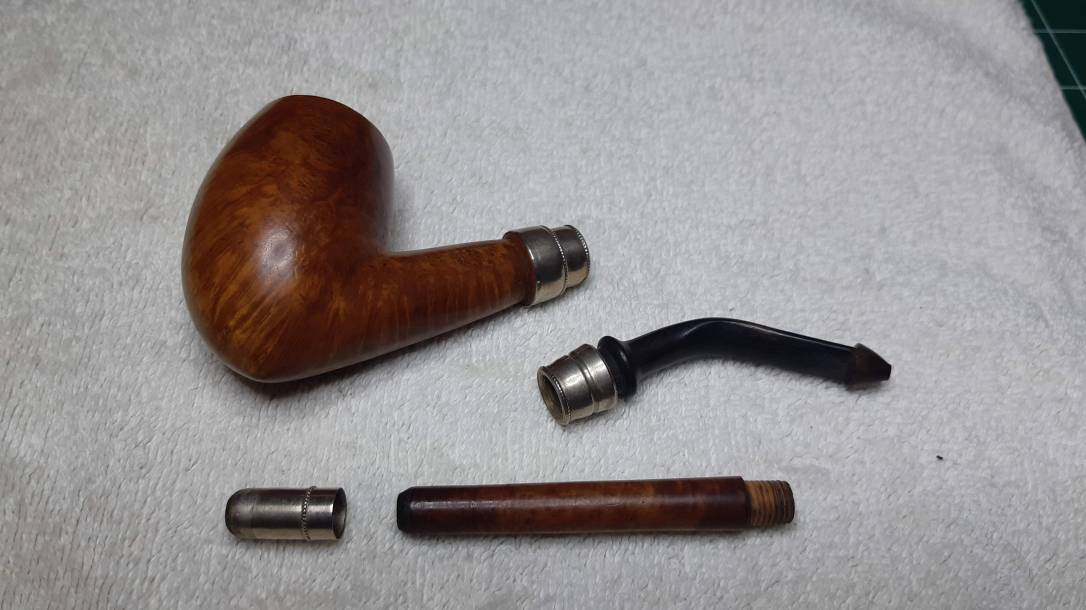
When I unscrewed the shank extension from the bit the nickel fitting between the two pieces also came off. Just as well, I thought, as it would allow me to work on the stem without worrying about accidentally scratching the metal.
My first job was to clean the pipe. As mentioned already, the pipe hadn’t seen a lot of use, so it only took a few pipe cleaners dipped in alcohol to sort out the internals. I used a cotton pad dipped in alcohol to clean the exterior of all the pieces, then used the same pad to wipe out the chamber, tidying up the small bit of carbon there.




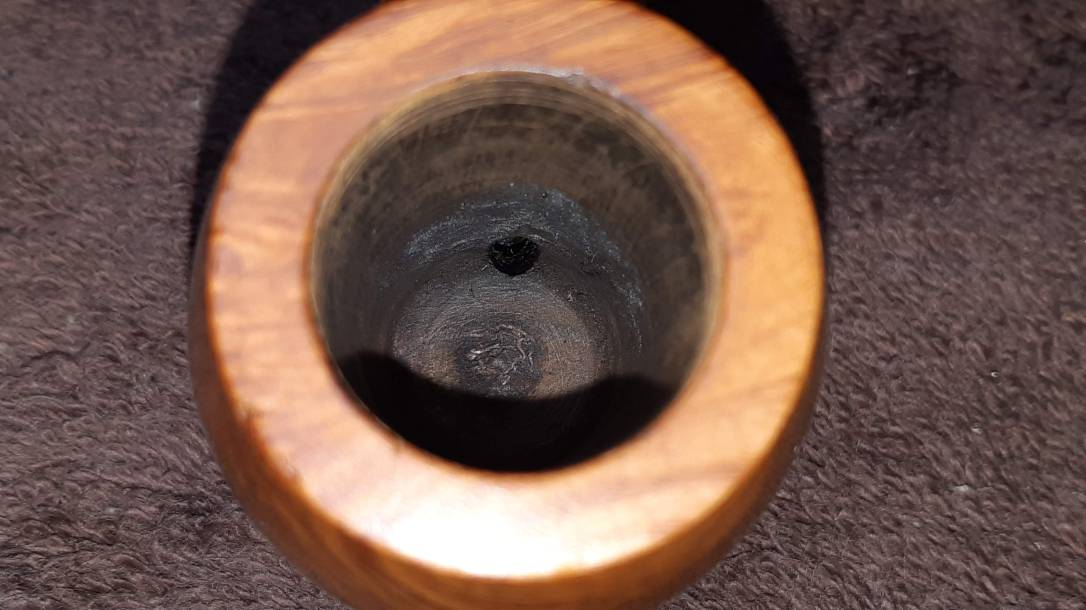
The stem looked rather blotchy and disreputable up close, so I popped it into an Oxyclean bath for a soak. My plan was to remove the oxidation and return the stem to a nice black colour.


As it turned out, the Oxy soak had no affect on the blotches, which was my first indication that the stem was not made from vulcanite as I had originally assumed. A bit of sanding with 220 grit paper to smooth out a few marks revealed the truth – the stem was acrylic, made in a faux bone pattern of blacks and greys.
With that little mystery sorted, I finished smoothing and polishing the stem. I worked my way through 220 and 320 grit sandpapers, 0000 steel wool and finally 800 and 2000 grit wet papers. With each grade of abrasive the faux bone pattern in the stem became more and more clear.


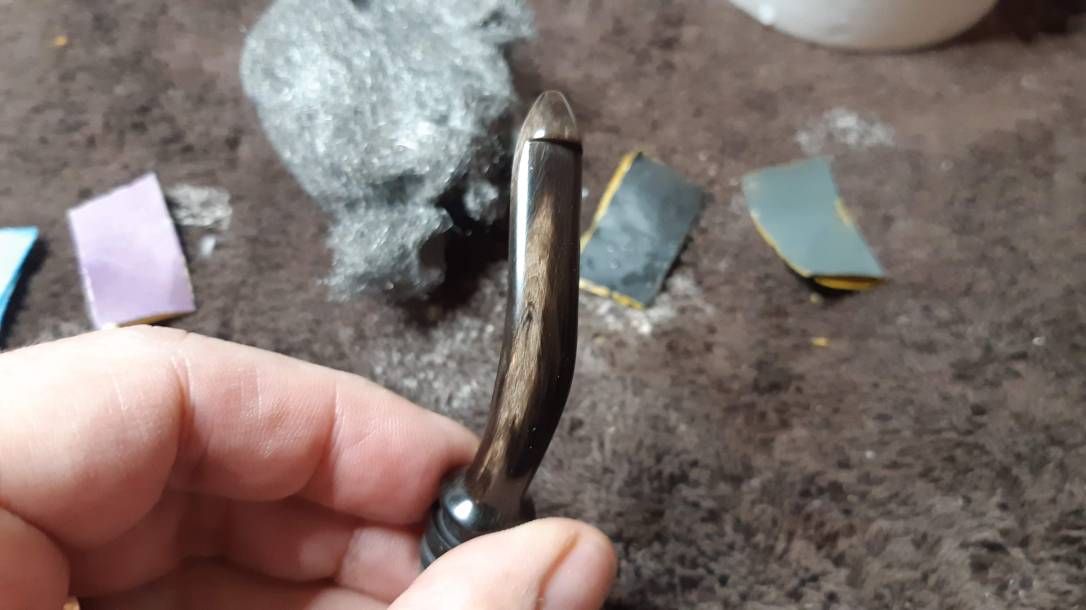
I set the stem aside at this point and worked on the rest of the pipe. A dab of CA glue on the inside of the shank cap secured the fitting in place on the end of the shank extension.

I then set to work raising the rim dents using a wet cotton pad and my soldering iron as a heat source to steam the wood fibres back into their original positions. Steam also raises the grain around the dents, so I sanded and polished the repaired area afterwards.

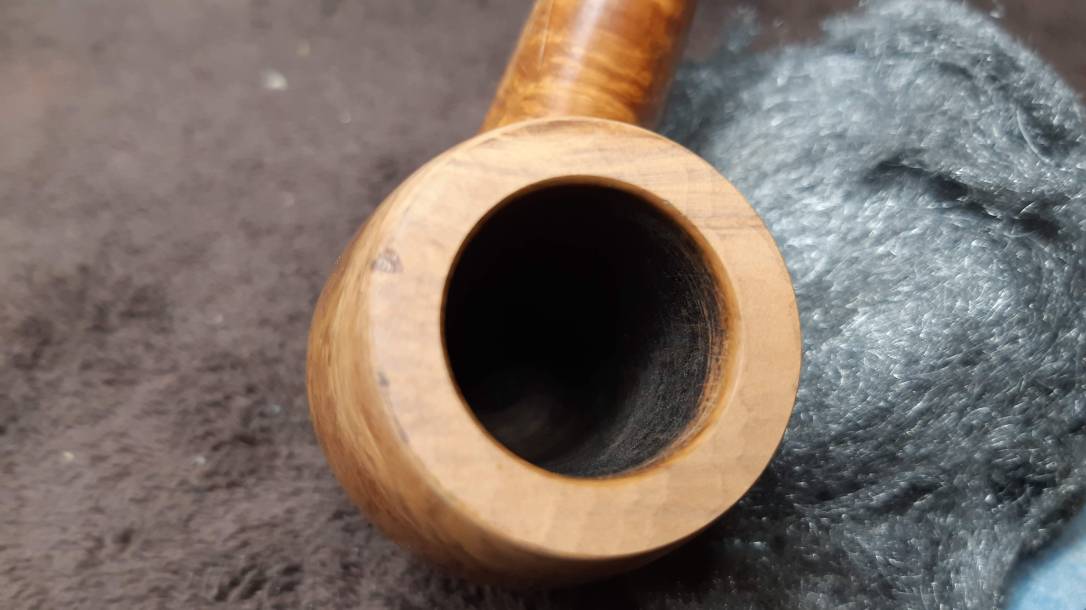
A quick touch-up with my lightest stain pen matched the sanded rim to the original stain on the rest of the briar.

With the very minor repairs finished, I brought the pieces of the pipe to the buffer for a run of White Diamond on the wheel. I buffed each piece separately for fear of sending parts flying about the workshop, then applied a few light coats of Carnauba wax.
This unique Wally Frank pipe is looking good after its refresher. It’s certainly an eye-catcher with lots of shiny briar and a fair bit of bling from the nickel fittings. If you’d like to add this French longpipe to your own rack or collection, it is now available on the Pipe Inventory page.
Thanks for joining me for this quick refurb. I enjoyed working on it and learning about the history of both Wally Frank Ltd and Butz-Choquin.
Until next time, Happy Piping! Here’s the finished pipe.







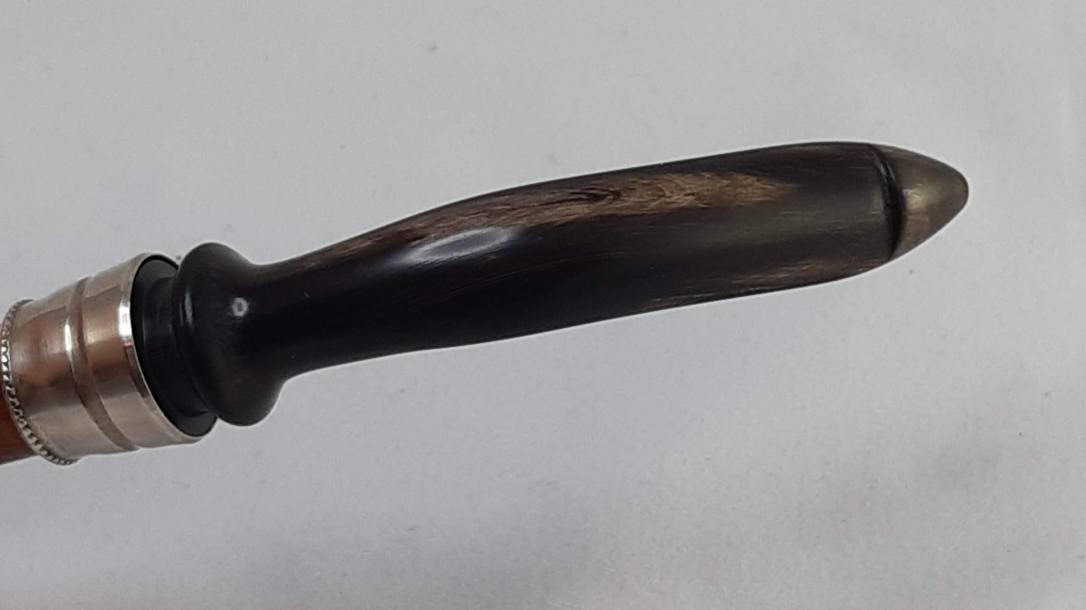






Reblogged this on rebornpipes and commented:
Nicely done Charles. It is a lot like the BC pipes of that line that I have worked on.
LikeLiked by 1 person
Thanks, Steve. It’s a good looking pipe with a real vintage feel. It will be perfect for someone’s collection!
LikeLike
I think I may have just purchased this exact pipe on eBay! Got it in the mail today. Same markings on mouthpiece, spot on rim of bowl, and imperfection on one of the bands. It is gorgeous and I just gave it another refresher, very clean pipe and great smoker!
LikeLike
Very cool! Thanks for sharing.
LikeLike